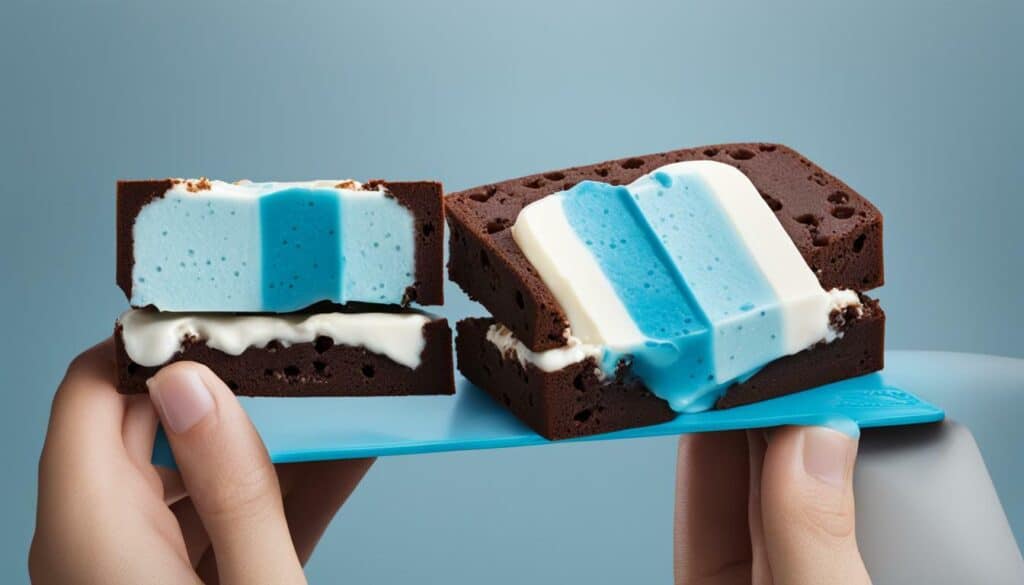Indulging in an ice cream sandwich is a sweet delight, but have you ever wondered about its calorie content and nutritional facts? Whether you’re watching your calorie intake or simply curious about what goes into your favorite frozen treat, understanding the nutritional information of an ice cream sandwich can help you make informed choices and enjoy it in moderation.
- Knowing the calorie content and nutritional facts of an ice cream sandwich can help you make informed choices.
- Different flavors of ice cream sandwiches may have varying nutritional profiles, including calories, fat content, saturated fat, cholesterol, sodium, carbohydrates, sugars, protein, and vitamins.
- You can craft your own low-calorie ice cream sandwiches using graham crackers and fat-free whipped topping.
- Consider the impact of side orders and condiments on the overall calorie content of your ice cream sandwich experience.
- Explore the nutritional information of other frozen treats, such as floats, shakes, and novelty items, to make informed choices.
In the following sections, we’ll dive into the nutritional information of different ice cream sandwich flavors, provide a guilt-free recipe for low-calorie ice cream sandwiches, and explore the nutritional facts of various frozen treats, savory options, and breads commonly paired with ice cream sandwiches. By the end, you’ll have a comprehensive understanding of the calories in an ice cream sandwich and be equipped to make delicious and informed choices.
Ice Cream Sandwich Nutrition Facts: A Flavorful Breakdown
Let’s take a closer look at the detailed nutrition facts of various ice cream sandwich flavors, shedding light on their calorie count and overall nutritional value. Understanding the nutritional information of your favorite ice cream sandwich can help you make informed choices and enjoy this delightful treat responsibly.
Below, you’ll find a table summarizing the nutritional information for different ice cream sandwich flavors. The values provided are approximate and may vary depending on the brand and specific ingredients used.
| Flavor | Serving Size | Calories | Fat Content | Saturated Fat | Cholesterol | Sodium | Carbohydrates | Sugars | Protein | Vitamin Content |
|---|---|---|---|---|---|---|---|---|---|---|
| Vanilla | 1 sandwich (70g) | 180 | 7g | 4.5g | 20mg | 120mg | 26g | 16g | 3g | 2% Vitamin A, 15% Calcium |
| Chocolate | 1 sandwich (70g) | 190 | 8g | 5g | 25mg | 130mg | 27g | 17g | 3g | 4% Vitamin A, 10% Calcium |
| Strawberry | 1 sandwich (70g) | 170 | 6g | 4g | 15mg | 100mg | 25g | 15g | 3g | 6% Vitamin A, 20% Calcium |
As you can see, the calorie count of an ice cream sandwich can vary depending on the flavor, with chocolate typically containing slightly more calories than vanilla or strawberry. It’s important to note that while ice cream sandwiches can be a delicious treat, they should be enjoyed in moderation as part of a balanced diet.
By being aware of the nutritional information provided, you can make conscious choices about your ice cream sandwich consumption and choose flavors that align with your dietary needs and preferences. Remember to savor your ice cream sandwich, and indulge responsibly!

Want to enjoy the deliciousness of an ice cream sandwich without the guilt? Here’s a simple recipe for crafting low-calorie versions right at home, complete with their nutritional value. By making a few easy swaps, you can satisfy your sweet tooth while keeping your calorie intake in check.
To start, you’ll need:
- 8 graham cracker squares
- 1 cup of fat-free whipped topping
- 1 teaspoon of vanilla extract
- Optional: sprinkles or mini chocolate chips for garnish
Begin by spreading a generous dollop of fat-free whipped topping on one side of a graham cracker square. Top it with another graham cracker square, pressing down gently to create a sandwich. Repeat this process until you have four sandwiches.
To finish, place the sandwiches in the freezer for at least two hours or until they’re firm. The fat-free whipped topping will freeze nicely, creating a creamy texture that perfectly complements the crunchy graham crackers. If desired, you can roll the edges of your frozen sandwiches in sprinkles or mini chocolate chips for an extra touch of fun.
| Nutrition Facts | Per Serving |
|---|---|
| Calories | 120 |
| Total Fat | 0g |
| Saturated Fat | 0g |
| Cholesterol | 0mg |
| Sodium | 150mg |
| Carbohydrates | 29g |
| Sugars | 14g |
| Protein | 1g |
| Vitamin A | 0% |
| Vitamin C | 0% |
| Calcium | 2% |
| Iron | 2% |
With just 120 calories per serving, these low-calorie ice cream sandwiches are a guilt-free treat that you can enjoy any time. They’re perfect for satisfying your sweet tooth while still sticking to your health goals. So go ahead, indulge in the creamy goodness of a homemade ice cream sandwich without worrying about the extra calories!

While ice cream sandwiches are delightful, there’s a whole world of frozen treats to discover, each with its own nutritional information worth exploring. Whether you’re a fan of floats, shakes, or novelty items, it’s important to be aware of the calorie content and nutritional value of these frozen indulgences. To help you make informed choices, let’s dive into the nutritional facts of some popular frozen treats.
First, let’s take a look at floats and shakes. These creamy concoctions often combine ice cream with soda or milk, resulting in a delightful blend of flavors. While they may be tempting, it’s important to remember that they can be high in calories. For example, a classic root beer float can contain up to 350 calories and a chocolate milkshake can have over 500 calories. If you’re looking for a lighter option, consider choosing low-fat or non-dairy alternatives and opting for smaller serving sizes.
Next, let’s explore the frozen dessert offerings from Upstate Farms and Abbott’s Custard. Upstate Farms offers a variety of ice cream flavors, from classics like vanilla and chocolate to unique options like salted caramel swirl. Abbott’s Custard, on the other hand, specializes in creamy custard flavors, including favorites like chocolate and mint chip. While these frozen treats are undoubtedly delicious, it’s important to enjoy them in moderation. Remember to check the nutritional information on the packaging and consider opting for smaller portion sizes or sharing with a friend to keep your calorie intake in check.
Finally, let’s not forget about the beloved cannoli. This traditional Italian pastry is often filled with a sweet ricotta cheese mixture and topped with powdered sugar. While it may not be a frozen treat in the traditional sense, it’s worth mentioning for its indulgent nature. A typical cannoli can contain anywhere from 200 to 300 calories, depending on the size and filling. If you’re looking for a lighter alternative, consider making your own cannoli using low-fat ricotta cheese or opting for smaller, mini cannoli.
Remember, enjoying frozen treats is all about balance and moderation. While it’s perfectly fine to indulge occasionally, being mindful of the nutritional information can help you make informed choices and maintain a healthy lifestyle. So go ahead, savor that ice cream sandwich or sip on a delicious float, but also explore the vast array of frozen treats available and discover new favorites that fit your dietary needs and preferences.

Making Informed Choices: Understanding the Impact of Sides and Add-Ons
It’s not just the ice cream sandwich itself that contributes to your calorie intake; the sides and condiments can make a significant impact too. Let’s take a closer look at their nutritional facts.
When it comes to side orders, it’s important to be mindful of their impact on your overall calorie consumption. While a side of fries or onion rings may be tempting, these deep-fried delights can quickly add up and derail your calorie goals. A small order of fries can contain around 230 calories, while a medium order of onion rings can have up to 400 calories. Opting for a side of fresh fruit or a side salad instead can help you save calories and add some extra nutrients to your meal.
Condiments are another factor to consider. While they may seem innocent, they can often be hidden sources of added sugars and calories. A dollop of mayonnaise or a drizzle of ketchup on your sandwich can easily add extra calories without much nutritional value. Opting for healthier options like mustard, salsa, or vinegar-based dressings can add flavor without packing on the pounds. Be sure to check the nutrition labels on condiment bottles to make informed choices and keep your calorie intake in check.
Table: Nutritional Information of Common Sides and Condiments
| Side/Condiment | Calories | Total Fat (g) | Carbohydrates (g) | Sugars (g) | Protein (g) |
|---|---|---|---|---|---|
| French Fries (small) | 230 | 11 | 29 | 0 | 3 |
| Onion Rings (medium) | 400 | 22 | 44 | 4 | 4 |
| Fresh Fruit Salad (cup) | 60 | 0 | 15 | 12 | 1 |
| Side Salad (without dressing) | 10 | 0 | 2 | 0 | 1 |
| Mayonnaise (1 tbsp) | 90 | 10 | 0 | 0 | 0 |
| Ketchup (1 tbsp) | 20 | 0 | 5 | 4 | 0 |
| Mustard (1 tbsp) | 0 | 0 | 0 | 0 | 0 |
| Salsa (1 tbsp) | 5 | 0 | 1 | 1 | 0 |
| Vinegar-Based Dressing (2 tbsp) | 30 | 0 | 2 | 2 | 0 |
By paying attention to the nutritional facts of sides and condiments, you can enjoy your ice cream sandwich without sabotaging your calorie goals. Opt for healthier options and be mindful of serving sizes to make informed choices that align with your dietary needs and preferences.

Ice cream sandwiches go hand in hand with savory food options. Let’s explore the nutritional facts of popular choices like beef and pork products, chicken products, soy products, and seafood products.
When it comes to beef and pork products, it’s important to note that different cuts and preparations can significantly impact the calorie content. Lean cuts of beef, such as sirloin or tenderloin, generally have fewer calories compared to fattier cuts like ribeye or T-bone. Pork tenderloin and loin chops are leaner options, while pork ribs and bacon tend to be higher in calories and fat. Remember to consider portion sizes and cooking methods, as frying or breading can add extra calories.
Chicken is a lean source of protein and can be a healthier option when compared to beef or pork. Skinless chicken breast has the lowest calorie content, while dark meat, such as chicken thighs or drumsticks, contains slightly more calories. Grilled, baked, or roasted chicken is generally lower in calories compared to fried or breaded varieties. Opting for skinless chicken and removing visible fat can further reduce the calorie content.
For those following a vegetarian or plant-based diet, soy products such as tofu and tempeh are excellent sources of protein. These options are lower in calories compared to meat and can be versatile in various savory dishes. They can be a great alternative if you’re looking to reduce your calorie intake while still enjoying a satisfying meal. However, it’s important to note that certain soy-based products like veggie burgers or soy-based processed foods may contain additional ingredients that can affect their calorie content. Always check the packaging for nutrition facts and ingredient lists.
| Soy Product | Calories per Serving |
|---|---|
| Tofu | 94 |
| Tempeh | 162 |
Seafood can be a delicious and nutritious option to pair with your ice cream sandwich. Fish such as salmon, trout, and sardines are rich in heart-healthy omega-3 fatty acids and generally lower in calories compared to other types of protein. Grilling, baking, or steaming seafood can help preserve its nutritional value while keeping the calorie content in check. However, some seafood options, like fried fish or shellfish in creamy sauces, can be higher in calories. Be mindful of portion sizes and cooking methods when enjoying seafood alongside your favorite frozen treat.

By understanding the nutritional facts of savory options like beef and pork products, chicken products, soy products, and seafood products, you can make informed choices when building your ice cream sandwich experience. Remember to consider portion sizes, cooking methods, and the overall balance of components in your meal. Enjoying your frozen treat with a side of healthy savory options can create a balanced and satisfying dining experience.
Nutritional Facts of Breads and Cannoli Pairings
The bread used in an ice cream sandwich can greatly impact its overall nutritional value, and let’s not forget about the classic cannoli. Here’s a closer look at their nutritional facts.
When it comes to the bread in an ice cream sandwich, the calories can vary depending on the type used. A typical slice of white bread contains around 80 calories, while a whole wheat slice can have around 100 calories. Opting for whole wheat bread not only provides a slightly higher calorie count but also offers additional fiber and nutrients. If you’re looking for a lower-calorie option, consider using a light or thin bread, which can range from 45 to 70 calories per slice.
Now, onto the beloved cannoli. This traditional Italian pastry consists of a fried pastry shell filled with a creamy ricotta filling. A single cannoli can range from 200 to 250 calories, with around 12 grams of fat. However, it’s important to note that cannoli sizes can vary, so these values are just an estimate. If you’re watching your calorie intake, consider sharing a cannoli or opting for a mini version, which can have about half the calories.
Pairing the right bread and cannoli can enhance your ice cream sandwich experience. Choose a bread that fits your dietary needs and preferences, whether it’s whole wheat for added nutrients or a light option for fewer calories. And when indulging in a cannoli, enjoy it mindfully and savor each bite. Remember, moderation is key when it comes to enjoying these delightful treats!
Conclusion
Understanding the calorie content of an ice cream sandwich empowers you to make informed choices and enjoy this delightful treat in moderation. In this comprehensive guide, we have explored the various flavors of ice cream sandwiches and their nutritional information, including serving sizes, calories, fat content, carbohydrates, and more. Armed with this knowledge, you can select an ice cream sandwich that best aligns with your dietary needs and goals.
For those looking to indulge without compromising on their calorie intake, we have provided a guilt-free recipe for crafting low-calorie ice cream sandwiches using graham crackers and fat-free whipped topping. This delicious alternative allows you to satisfy your cravings while keeping an eye on your calorie count.
Furthermore, we have gone beyond ice cream sandwiches and dived into the nutritional information of other frozen treats, side orders, condiments, and even savory options like beef and pork products, chicken products, soy products, and seafood products. By understanding the impact of these additional elements, you can make well-informed decisions and create a balanced ice cream sandwich experience.
Finally, we’ve explored the nutritional facts of breads commonly used for ice cream sandwiches and the traditional Italian pastry, cannoli. These insights provide a holistic view of the various components that can enhance or alter the nutritional profile of your frozen treat.
So go ahead, indulge in an ice cream sandwich of your choice, armed with the knowledge of its calorie content and nutritional value. By making conscious decisions and practicing moderation, you can savor every bite with confidence, knowing that you’re taking care of your health and well-being.
FAQ
Q: How many calories are in an ice cream sandwich?
A: The number of calories in an ice cream sandwich varies depending on the flavor and brand. Refer to Section 2 for a detailed breakdown of the nutritional information of different ice cream sandwich flavors.
Q: What is the serving size of an ice cream sandwich?
A: The serving size of an ice cream sandwich also depends on the brand and flavor. Check Section 2 for specific serving size information.
Q: How can I make low-calorie ice cream sandwiches at home?
A: Section 3 provides a guilt-free recipe for making your own low-calorie ice cream sandwiches using graham crackers and fat-free whipped topping.
Q: What are the nutritional facts of other frozen treats?
A: Beyond ice cream sandwiches, Section 4 explores the nutritional information of other frozen treats such as floats, shakes, Upstate Farms ice cream products, Abbott’s Custard products, and novelty items.
Q: How do side orders and condiments impact the calorie content of my ice cream sandwich?
A: Section 5 focuses on the impact of side orders and condiments on the overall calorie content of your ice cream sandwich experience. It explores the nutritional information of various side orders and condiments commonly paired with frozen treats.
Q: What are the nutritional facts of savory options?
A: Moving beyond sweet treats, Section 6 uncovers the nutritional information of savory food options often enjoyed alongside ice cream sandwiches. It explores the calorie content of beef and pork products, chicken products, soy products, and seafood products.
Q: What are the nutritional facts of breads and cannoli pairings?
A: Section 7 focuses on the nutritional facts of breads commonly used for ice cream sandwiches and the traditional Italian pastry, cannoli.
How Many Carbs are There in an Ice Cream Sandwich?
When it comes to indulging in a sweet treat like an ice cream sandwich, many wonder about the number of carbs it contains. The creamy ice cream nestled between two soft cookies or, in some cases, unveiling the carbs in french bread, holds a certain level of mystery. However, it’s crucial to note that the carb content varies based on the brand, size, and ingredients used. Checking the nutrition label is the best way to determine the precise carb count in an ice cream sandwich.






Leave a Reply